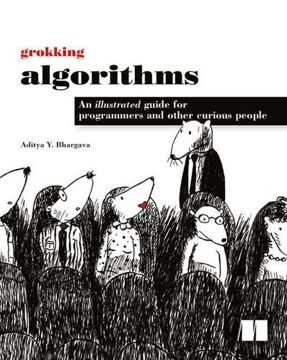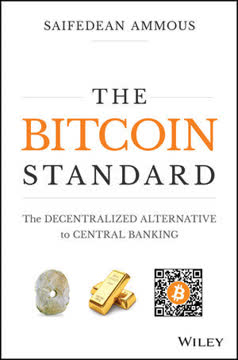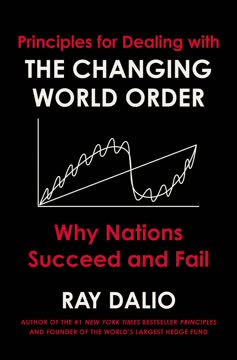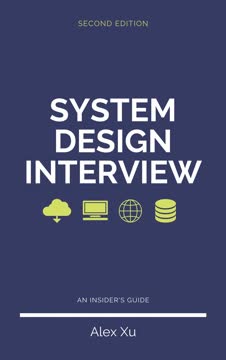نکات کلیدی
1. بلاکچین: فناوری دفتر کل توزیعشده انقلابی
بلاکچین در اصل یک دفتر کل توزیعشده همتا به همتا است که از نظر رمزنگاری ایمن، فقط بهصورت الحاقی، غیرقابل تغییر (بسیار دشوار برای تغییر) و فقط از طریق توافق یا توافق میان همتاها قابل بهروزرسانی است.
معماری توزیعشده. فناوری بلاکچین بر روی شبکهای از کامپیوترها عمل میکند که هر یک نسخهای از دفتر کل را نگهداری میکنند. این رویکرد غیرمتمرکز نیاز به یک نهاد مرکزی را از بین میبرد و امنیت و شفافیت را افزایش میدهد.
غیرقابل تغییر بودن و توافق. هنگامی که دادهها در بلاکچین ثبت میشوند، تغییر آنها بسیار دشوار میشود. این غیرقابل تغییر بودن از طریق تکنیکهای رمزنگاری و مکانیزم توافق، که در آن شرکتکنندگان شبکه باید بر صحت تراکنشهای جدید قبل از اضافه شدن به دفتر کل توافق کنند، تضمین میشود.
ویژگیهای کلیدی بلاکچین:
- غیرمتمرکز بودن
- شفافیت
- امنیت
- غیرقابل تغییر بودن
- بهروزرسانیهای مبتنی بر توافق
2. بیتکوین: اولین و برجستهترین کاربرد بلاکچین
بیتکوین در سال 2009 منتشر شد و اولین پروژه سکه جایگزین (به نام Namecoin) در سال 2011 معرفی شد.
رمزنگاری پیشگام. بیتکوین، که توسط ساتوشی ناکاموتو معرفی شد، اولین پیادهسازی موفق فناوری بلاکچین بود. این فناوری مشکل دوبارهخرجی در ارزهای دیجیتال را بدون نیاز به یک طرف سوم مورد اعتماد حل کرد.
مکانیزم توافق اثبات کار. بیتکوین از مکانیزم اثبات کار (PoW) برای تأیید تراکنشها و ایجاد بلوکهای جدید استفاده میکند. ماینرها برای حل معماهای ریاضی پیچیده رقابت میکنند و برنده حق اضافه کردن بلوک بعدی به زنجیره و دریافت بیتکوینهای تازه ضربشده به عنوان پاداش را به دست میآورد.
اجزای کلیدی بیتکوین:
- شبکه غیرمتمرکز گرهها
- رمزنگاری کلید عمومی و خصوصی
- بلاکچین به عنوان دفتر کل عمومی
- فرآیند ماینینگ برای تأیید تراکنش
- عرضه محدود 21 میلیون سکه
3. اتریوم: بلاکچین برنامهپذیر با قراردادهای هوشمند
اتریوم در نوامبر 2013 توسط ویتالیک بوترین مفهومسازی شد. ایده کلیدی پیشنهادی توسعه یک زبان کامل تورینگ بود که امکان توسعه برنامههای دلخواه (قراردادهای هوشمند) برای بلاکچین و برنامههای غیرمتمرکز را فراهم میکند.
پلتفرم قراردادهای هوشمند. اتریوم فناوری بلاکچین را فراتر از انتقال ساده ارزش گسترش میدهد و امکان ایجاد و اجرای توافقات پیچیده و برنامهپذیر به نام قراردادهای هوشمند را فراهم میکند. این قراردادها میتوانند فرآیندها و تعاملات مختلف را بدون واسطهها خودکار کنند.
ماشین مجازی اتریوم (EVM). EVM یک کامپیوتر غیرمتمرکز است که قراردادهای هوشمند را اجرا میکند. این امکان را برای توسعهدهندگان فراهم میکند تا برنامههای غیرمتمرکز (DApps) را با استفاده از زبانهایی مانند سالیدیتی ایجاد کنند که سپس به کد بایت EVM برای اجرا در شبکه تبدیل میشوند.
اجزای اکوسیستم اتریوم:
- اتر (ETH) به عنوان ارز دیجیتال بومی
- گاز برای هزینههای تراکنش و محاسبات
- برنامههای غیرمتمرکز (DApps)
- پیشنهادات بهبود اتریوم (EIPs) برای بهروزرسانی پروتکل
4. سکههای جایگزین: ارزهای دیجیتال متنوع فراتر از بیتکوین
از زمان موفقیت اولیه بیتکوین، پروژههای ارز جایگزین زیادی راهاندازی شدهاند.
چشمانداز متنوع ارزهای دیجیتال. سکههای جایگزین، یا آلتکوینها، برای رفع محدودیتهای درکشده بیتکوین یا خدمت به موارد استفاده خاص ظهور کردهاند. این سکهها اغلب ویژگیها یا مکانیزمهای توافق نوآورانهای را معرفی میکنند.
نوآوریهای فناوری. بسیاری از آلتکوینها مفاهیم جدیدی مانند حریم خصوصی بهبود یافته (مانند مونرو، زکش)، زمانهای تراکنش سریعتر (مانند لایتکوین) یا مکانیزمهای توافق متفاوت (مانند اثبات سهام در کاردانو) را معرفی کردهاند.
دستهبندیهای قابل توجه آلتکوینها:
- سکههای حریم خصوصی
- استیبلکوینها
- توکنهای کاربردی
- توکنهای حاکمیتی
- سکههای متمرکز بر تعاملپذیری
5. قراردادهای هوشمند: توافقات خوداجرا در بلاکچین
قرارداد هوشمند یک برنامه کامپیوتری امن و غیرقابل توقف است که نمایانگر یک توافق است که بهطور خودکار قابل اجرا و قابل اجرا است.
توافقات خودکار. قراردادهای هوشمند برنامههای خوداجرا هستند که در بلاکچین ذخیره میشوند و زمانی که شرایط از پیش تعیینشده برآورده شوند، اجرا میشوند. آنها اجرای توافقات را خودکار میکنند و نیاز به واسطهها را کاهش میدهند و الزامات اعتماد را به حداقل میرسانند.
کاربردهای گسترده. قراردادهای هوشمند دارای کاربردهای بالقوه در صنایع مختلف، از جمله مالی، مدیریت زنجیره تأمین، املاک و مستغلات و بهداشت و درمان هستند. آنها میتوانند منطق تجاری پیچیده را خودکار کنند، داراییهای دیجیتال را مدیریت کنند و تراکنشهای شفاف و کارآمد را تسهیل کنند.
قابلیتهای قراردادهای هوشمند:
- اجرای خودکار توافقات
- کاهش نیاز به واسطهها
- افزایش شفافیت و اعتماد
- منطق تجاری برنامهپذیر
- ادغام با منابع داده خارجی (اوراکلها)
6. هایپرلجر: راهحلهای بلاکچین متنباز برای کسبوکار
هایپرلجر یک بلاکچین نیست، بلکه پروژهای است که توسط بنیاد لینوکس در دسامبر 2015 برای پیشبرد فناوری بلاکچین آغاز شد.
توسعه بلاکچین مشارکتی. هایپرلجر یک پروژه چتر است که میزبان چارچوبها و ابزارهای مختلف بلاکچین طراحیشده برای استفاده در کسبوکار است. هدف آن ایجاد فناوریهای بلاکچین متنباز و بینصنعتی است که میتوانند برای ساخت و پیادهسازی راهحلهای تجاری قوی استفاده شوند.
معماری مدولار. پروژههای هایپرلجر، مانند فابریک و سوتوث، پلتفرمهای بلاکچین مدولار و قابل تنظیم را ارائه میدهند. این امکان را برای سازمانها فراهم میکند تا اجزایی را انتخاب کنند که بهترین تناسب را با نیازهای خاص آنها داشته باشد، از جمله مکانیزمهای توافق، مدیریت هویت و محیطهای قرارداد هوشمند.
پروژههای کلیدی هایپرلجر:
- فابریک: چارچوب بلاکچین مدولار
- سوتوث: پلتفرم بلاکچین انعطافپذیر با توافق نوین (PoET)
- ایروها: چارچوب بلاکچین مناسب برای موبایل
- ایندی: بلاکچین هویت غیرمتمرکز
- بزو: پلتفرم بلاکچین سازگار با اتریوم
7. رمزنگاری: ستون فقرات امنیت بلاکچین
رمزنگاری علم ایجاد امنیت اطلاعات در برابر دشمنان است.
لایه امنیتی بنیادی. رمزنگاری پایه و اساس امنیت بلاکچین را تشکیل میدهد و یکپارچگی، محرمانگی و اصالت تراکنشها و دادههای ذخیرهشده در شبکه را تضمین میکند. این امکان را برای ارتباطات امن و توافق در یک محیط بدون اعتماد فراهم میکند.
مفاهیم کلیدی رمزنگاری. فناوری بلاکچین به انواع مختلفی از اصول رمزنگاری، از جمله رمزنگاری کلید عمومی، توابع هش و امضاهای دیجیتال وابسته است. این عناصر بهطور مشترک برای ایجاد یک دفتر کل توزیعشده امن و مقاوم در برابر دستکاری کار میکنند.
اجزای اساسی رمزنگاری در بلاکچین:
- جفتهای کلید عمومی و خصوصی
- توابع هش (مانند SHA-256)
- امضاهای دیجیتال
- درختان مرکل
- اثباتهای صفر-دانش (در برخی پیادهسازیها)
8. غیرمتمرکز بودن: اصل اصلی محرک نوآوری بلاکچین
غیرمتمرکز بودن یک مفهوم جدید نیست؛ این مفهوم برای مدت طولانی در استراتژی، مدیریت و حکمرانی استفاده شده است. ایده اصلی غیرمتمرکز بودن توزیع کنترل و اختیار به حاشیهها به جای اینکه یک نهاد مرکزی بهطور کامل کنترل سازمان را در دست داشته باشد، است.
کنترل توزیعشده. غیرمتمرکز بودن در بلاکچین به توزیع قدرت و تصمیمگیری در میان شبکهای از شرکتکنندگان اشاره دارد و به جای اتکا به یک نهاد مرکزی، این رویکرد امنیت، تابآوری و مقاومت در برابر سانسور را افزایش میدهد.
تعاملات بدون اعتماد. با حذف نیاز به واسطهها، بلاکچین امکان تراکنشها و تعاملات مستقیم همتا به همتا را فراهم میکند. این مدل بدون اعتماد هزینهها را کاهش میدهد، کارایی را افزایش میدهد و امکانات جدیدی برای همکاری و تبادل ارزش ایجاد میکند.
مزایای غیرمتمرکز بودن در بلاکچین:
- افزایش امنیت از طریق توافق توزیعشده
- کاهش نقاط شکست واحد
- افزایش شفافیت و قابلیت حسابرسی
- مقاومت در برابر سانسور
- توانمندسازی شرکتکنندگان فردی
9. مکانیزمهای توافق: تضمین توافق در سیستمهای توزیعشده
توافق یک فرآیند توافق بین گرههای غیرقابل اعتماد بر روی یک وضعیت نهایی از دادهها است.
توافق در شبکههای بدون اعتماد. مکانیزمهای توافق پروتکلهایی هستند که به سیستمهای توزیعشده اجازه میدهند بدون نیاز به اعتماد بین شرکتکنندگان به توافق بر سر وضعیت شبکه برسند. این مکانیزمها برای حفظ یکپارچگی و سازگاری شبکههای بلاکچین حیاتی هستند.
رویکردهای متنوع. شبکههای بلاکچین مختلف بر اساس نیازها و تعهدات خاص خود از مکانیزمهای توافق مختلفی استفاده میکنند. این مکانیزمها شامل اثبات کار (بیتکوین)، اثبات سهام (اتریوم 2.0)، اثبات سهام نماینده (EOS) و انواع تحمل خطای بیزانسی هستند.
مکانیزمهای توافق محبوب:
- اثبات کار (PoW)
- اثبات سهام (PoS)
- اثبات سهام نماینده (DPoS)
- تحمل خطای بیزانسی عملی (PBFT)
- اثبات اعتبار (PoA)
10. مقیاسپذیری و چالشها: غلبه بر محدودیتهای بلاکچین
مقیاسپذیری در هر بلاکچین یک مسئله بنیادی است. امنیت نیز از اهمیت بالایی برخوردار است. مسائلی مانند حریم خصوصی و محرمانگی باعث ایجاد برخی مشکلات سازگاری، بهویژه در بخش مالی شدهاند.
سهگانه بلاکچین. فناوری بلاکچین با چالش دستیابی همزمان به مقیاسپذیری، امنیت و غیرمتمرکز بودن مواجه است. بهبود یک جنبه اغلب به قیمت به خطر انداختن دیگری تمام میشود و منجر به تلاشهای تحقیق و توسعه مداوم میشود.
راهحلهای نوآورانه. رویکردهای مختلفی برای حل مشکلات مقیاسپذیری بلاکچین در حال بررسی است، از جمله راهحلهای لایهدومی (مانند شبکه لایتنینگ برای بیتکوین، پلاسما برای اتریوم)، شاردینگ و مکانیزمهای توافق جایگزین. نگرانیهای حریم خصوصی و محرمانگی از طریق اثباتهای صفر-دانش و سایر تکنیکهای رمزنگاری مورد بررسی قرار میگیرند.
چالشهای کلیدی و راهحلهای بالقوه:
- مقیاسپذیری: راهحلهای لایهدومی، شاردینگ، مکانیزمهای توافق جدید
- حریم خصوصی: اثباتهای صفر-دانش، امضاهای حلقه، تراکنشهای محرمانه
- تعاملپذیری: پروتکلهای ارتباطی بین زنجیرهای
- مصرف انرژی: انتقال به اثبات سهام و سایر مکانیزمهای توافق کارآمد
- انطباق با مقررات: توسعه ابزارهای انطباق حفظ حریم خصوصی
آخرین بهروزرسانی::
FAQ
What is "Mastering Blockchain" by Imran Bashir about?
- Comprehensive blockchain guide: The book offers a thorough introduction to blockchain technology, covering both theoretical foundations and practical applications, including distributed ledgers, consensus mechanisms, and smart contracts.
- Wide-ranging coverage: It explores major blockchain platforms like Bitcoin, Ethereum, and Hyperledger, and delves into cryptography, development tools, and real-world use cases in finance, IoT, and government.
- Balanced for learners and professionals: Designed for readers with basic computer science knowledge, it serves as both a reference for developers and a textbook for blockchain courses.
- Focus on current and future trends: The book discusses industry challenges, ongoing research, and the evolving landscape of blockchain technology.
Why should I read "Mastering Blockchain" by Imran Bashir?
- In-depth technical foundation: The book equips readers with a solid understanding of blockchain’s core concepts, from cryptography to consensus algorithms and smart contracts.
- Practical development guidance: It provides hands-on advice for setting up blockchain environments, writing and deploying smart contracts, and using tools like Truffle and OpenSSL.
- Industry relevance and future outlook: Readers gain insights into current platforms, enterprise solutions, and emerging trends, preparing them for real-world blockchain projects.
- Accessible yet detailed: The book balances technical depth with clear explanations, making complex topics approachable for both beginners and experienced developers.
What are the key takeaways from "Mastering Blockchain" by Imran Bashir?
- Blockchain fundamentals: Readers learn about distributed systems, consensus mechanisms, cryptographic security, and the structure of blockchains.
- Smart contracts and applications: The book explains the definition, history, and implementation of smart contracts, highlighting their transformative potential.
- Ethereum and beyond: It provides a deep dive into Ethereum’s architecture, account models, gas mechanism, and development tools.
- Challenges and future directions: Key issues like scalability, privacy, and security are discussed, along with solutions and predictions for blockchain’s evolution.
What are the best quotes from "Mastering Blockchain" by Imran Bashir and what do they mean?
- On smart contracts: "A smart contract is a secure and unstoppable computer program representing an agreement that is automatically executable and enforceable." This emphasizes the automation and reliability of smart contracts.
- On blockchain’s core: "Blockchain at its core is a peer-to-peer distributed ledger that is cryptographically secure, append-only, immutable (extremely hard to change), and updateable only via consensus or agreement among peers." This highlights blockchain’s security and decentralized nature.
- On decentralization: "Decentralization is a core concept and benefit of blockchain. There is no need for a trusted third party or intermediary to validate transactions; instead a consensus mechanism is used to agree on the validity of transactions." This underscores the trustless, consensus-driven model of blockchain.
How does "Mastering Blockchain" by Imran Bashir explain the fundamental concepts of blockchain?
- Distributed systems and consensus: The book introduces blockchain as a decentralized system that uses consensus mechanisms to achieve agreement among nodes, addressing challenges like Byzantine faults.
- Blockchain structure: It describes blockchains as linked lists of blocks containing transactions, secured by cryptographic hash pointers.
- Types and features: Blockchains are categorized into public, private, semi-private, sidechains, tokenized, and tokenless, with features like immutability, transparency, and distributed consensus.
- Key components: Addresses, transactions, nodes, and smart contracts are explained as essential elements of blockchain networks.
What is the role of cryptography in blockchain according to "Mastering Blockchain" by Imran Bashir?
- Cryptographic foundations: The book covers symmetric and asymmetric cryptography, hash functions, digital signatures, and elliptic curve cryptography (ECC) as the backbone of blockchain security.
- Practical cryptography: Readers are guided through hands-on examples using OpenSSL for encryption, decryption, key generation, and digital signatures.
- Advanced techniques: Topics like zero-knowledge proofs, blind signatures, and homomorphic encryption are introduced, showing their importance for privacy and security.
- Security implications: The book explains how cryptography ensures data integrity, authentication, and non-repudiation in blockchain systems.
How does "Mastering Blockchain" by Imran Bashir describe Bitcoin and its underlying technology?
- Bitcoin as a pioneer: The book details Bitcoin’s history, its solution to the double-spending problem, and its use of Proof of Work (PoW) for decentralized consensus.
- Transaction structure and scripting: It explains how Bitcoin transactions are constructed, verified, and confirmed, including the use of scripting languages and multi-signature transactions.
- Mining and network: The evolution of mining hardware (CPU, GPU, FPGA, ASIC), mining pools, and network synchronization are covered in depth.
- Operational ecosystem: The roles of nodes, miners, and the process of block creation and validation are thoroughly explained.
What are alternative coins (altcoins) and how does "Mastering Blockchain" by Imran Bashir cover them?
- Definition and examples: Altcoins are described as cryptocurrencies developed after Bitcoin, including Namecoin, Litecoin, Primecoin, and Zcash.
- Innovations in consensus: The book discusses alternative consensus mechanisms like Proof of Stake, Proof of Storage, and hybrid models, as well as ASIC-resistant algorithms.
- Privacy and scalability: Privacy-focused coins like Zcash and scalability solutions are highlighted, illustrating the diversity and evolution of the cryptocurrency landscape.
- Security and challenges: The book addresses the unique challenges and innovations brought by altcoins in terms of security and network design.
How does "Mastering Blockchain" by Imran Bashir define and explain smart contracts?
- Smart contract definition: A smart contract is described as a secure, unstoppable program that automatically executes and enforces agreements without intermediaries.
- Historical context: The origins of smart contracts are traced to Nick Szabo, with comparisons to Ricardian contracts that blend legal prose and code.
- Implementation details: The book covers smart contract templates, domain-specific languages like Solidity, and the use of Oracles for external data.
- Security and challenges: Real-world incidents like The DAO hack are discussed to highlight the importance of smart contract security.
What is Ethereum and how does "Mastering Blockchain" by Imran Bashir explain its architecture?
- Ethereum’s innovation: Ethereum is presented as a blockchain platform with a Turing-complete language for complex smart contracts and decentralized applications.
- Core components: The book details Ethereum clients (geth, parity), the Ethereum Virtual Machine (EVM), account models, transactions, and the gas mechanism.
- Consensus and execution: Ethereum’s use of the GHOST protocol for consensus and the stack-based EVM for contract execution are explained.
- Development tools: Tools and frameworks for Ethereum development, such as Solidity, Truffle, and Remix, are introduced for practical application.
How does "Mastering Blockchain" by Imran Bashir explain Ethereum’s account model, transactions, and gas mechanism?
- Account types: The book distinguishes between Externally Owned Accounts (EOAs) controlled by private keys and Contract Accounts (CAs) with associated code.
- Transaction validation: Transactions are validated for syntax, signatures, nonce, gas, and balance, with invalid transactions being rejected and fees still paid.
- State transitions: Valid transactions update account balances, execute contract code, and consume gas, with state changes rolled back if gas runs out.
- Gas as computational fuel: Gas measures computational work, prevents network abuse, and is paid in ether, with detailed examples of gas costs and fee calculations.
What are the main challenges and future directions for blockchain technology according to "Mastering Blockchain" by Imran Bashir?
- Scalability and privacy: The book identifies scalability and privacy as major hurdles, discussing solutions like sharding, state channels, zero-knowledge proofs, and confidential transactions.
- Security and smart contract risks: Vulnerabilities such as transaction malleability, eclipse attacks, and smart contract bugs are highlighted, with formal verification tools introduced for mitigation.
- Standardization and research: Ongoing research in cryptography, consensus algorithms, and programming languages is emphasized to improve blockchain robustness.
- Industry adoption and trends: The book predicts growth in enterprise blockchains, convergence with IoT and AI, and blockchain’s integration into daily life and industry.
نقد و بررسی
کتاب استاد شدن در بلاکچین از سوی خوانندگان با استقبال بالایی مواجه شده و میانگین امتیاز آن ۴.۳۸ از ۵ است. منتقدان به پوشش جامع این کتاب از فناوری بلاکچین، از مبانی تا موضوعات پیشرفته، اشاره کرده و آن را بهترین کتاب در این زمینه میدانند که برای مبتدیان و حرفهایهای فناوری اطلاعات مناسب است. خوانندگان به عمق فنی، توضیحات شفاف و گنجاندن مفاهیم ریاضی در این کتاب ارج مینهند. برخی از آنها به عدم وضوح گاه و بیگاه و اطلاعات قدیمی آن انتقاد کردهاند. بهطور کلی، این کتاب بهعنوان منبعی ضروری برای درک فناوری بلاکچین بهطور گستردهای توصیه میشود و بسیاری از آن بهعنوان کتاب درسی یا راهنمای مرجع استفاده میکنند.
Similar Books














